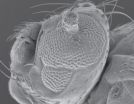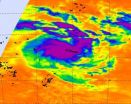(Press-News.org) Researchers at Michigan State University have discovered a protein that does its best work with one foot in the grave.
The study, which appears in the current issue of the Journal of Biological Chemistry, focuses on the nontraditional lifestyle of Retinoblastoma tumor suppressor proteins, which could lead to new ways to treat cancer.
"Retinoblastoma proteins are unique in that they use controlled destruction to do their jobs in a timely but restrained fashion," said Liang Zhang, a lead author and MSU cell and molecular biology graduate student. "This is an unusual way for proteins to act."
As an organism grows, proteins essential for fueling its prosperity typically toe a tight line, performing their jobs at the right place and time. If these proteins go rogue, disasters such as cancer can result.
Retinoblastoma proteins, which could be labeled as rebellious as opposed to rogue, perform acts of valor rather than destruction. And just like fireworks, they save their best work for the finale.
Proteins' lifecycles end with degradation, and like most living things they become weaker and less efficient at their jobs near the end of their lives. For Retinoblastoma proteins, however, their destruction is linked to their ability to efficiently control excessive cell growth.
Using the fruit fly Drosophila, MSU researchers isolated the specific region that controls the protein's ability to degrade. Strikingly, this is the same region the protein uses to hit its stride and exert its full power to suppress genes related to unrestrained cell growth. Other categories of genes, such as those linked to cell death, may not be influenced by this specific region that controls degradation. This sheds light on a single mechanism that controls both living and dying at the genetic level.
Identifying this mechanism in fruit flies could be beneficial to humans. David Arnosti, MSU biochemist and director of MSU's Gene Expression in Disease Development initiative, noted the genetic similarities between humans and Drosophila, describing fruit flies as "resembling little people with wings."
"By revealing the molecular details about the regulation of the fly Retinoblastoma protein, we can start to understand the possible roles of the human counterparts in cancer," he said.
INFORMATION:
The research was a product of NIH-funded research between the laboratories of Arnosti and R. William Henry, MSU biochemist.
Protein strongest just before death
2012-12-13
ELSE PRESS RELEASES FROM THIS DATE:
Experimental agent briefly eases depression rapidly in test
2012-12-13
A drug that works through the same brain mechanism as the fast-acting antidepressant ketamine briefly improved treatment-resistant patients' depression symptoms in minutes, with minimal untoward side effects, in a clinical trial conducted by the National Institutes of Health. The experimental agent, called AZD6765, acts through the brain's glutamate chemical messenger system.
Existing antidepressants available through prescription, which work through the brain's serotonin system, take a few weeks to work, imperiling severely depressed patients, who can be at high risk ...
Study reveals new factor that could limit the life of hybrid and electric car batteries
2012-12-13
COLUMBUS, Ohio – A new study of the batteries commonly used in hybrid and electric-only cars has revealed an unexpected factor that could limit the performance of batteries currently on the road.
Researchers led by Ohio State University engineers examined used car batteries and discovered that over time lithium accumulates beyond the battery electrodes – in the "current collector," a sheet of copper which facilitates electron transfer between the electrodes and the car's electrical system.
This knowledge could aid in improving design and performance of batteries, explained ...
NASA sees newborn Tropical Storm Evan causing trouble for American Samoa
2012-12-13
The date 12-12-12 may be numerically significant, but for the residents of American Samoa and Fiji in the South Pacific Ocean, it means a newborn tropical storm named Evan is causing problems. NASA's Aqua satellite and NOAA's GOES-15 satellite both captured imagery of the newborn storm's cloud cover.
Tropical Storm Evan caused regional warnings to be posted on Dec. 12. In American Samoa, a gale warning and storm watch are in effect for Tutuila, Aunuu, Manua and Swains Island.
The Atmospheric Infrared Sounder (AIRS) instrument aboard NASA's Aqua satellite captured an ...
Ceramic indoor cookstove use did not significantly lower child pneumonia risk in rural Kenya
2012-12-13
DEERFIELD, Il. (December 11, 2012)—Inexpensive, locally-produced ceramic cookstoves may produce less smoke than traditional indoor 3-stone firepits, but they don't significantly reduce indoor air pollution or the risk of pneumonia in young children, according to results from a small, year-long observational study by researchers working in rural Kenya.
The findings, published online today in the American Journal of Tropical Medicine and Hygiene, are the first to examine the health impacts of ceramic cookstoves that do not vent smoke to the outside of the house, said Robert ...
X-ray laser takes aim at cosmic mystery
2012-12-13
An international collaboration including researchers from Lawrence Livermore National Laboratory has refined a key process in understanding extreme plasmas such as those found in the sun, stars, at the rims of black holes and galaxy clusters.
In short, the team identified a new solution to an astrophysical phenomenon through a series of laser experiments.
In the new research, appearing in the Dec. 13 edition of the journal Nature, scientists looked at highly charged iron using the Linac Coherent Light Source (LCLS) free-electron laser. Highly charged iron produces ...
ASU researchers propose new way to look at the dawn of life
2012-12-13
TEMPE, Ariz. – One of the great mysteries of life is how it began. What physical process transformed a nonliving mix of chemicals into something as complex as a living cell?
For more than a century, scientists have struggled to reconstruct the key first steps on the road to life. Until recently, their focus has been trained on how the simple building blocks of life might have been synthesized on the early Earth, or perhaps in space. But because it happened so long ago, all chemical traces have long been obliterated, leaving plenty of scope for speculation and disagreement.
Now, ...
Got food allergies? Thanks to UCLA, you can test your meal on the spot using a cell phone
2012-12-13
Are you allergic to peanuts and worried there might be some in that cookie? Now you can find out using a rather unlikely source: your cell phone.
A team of researchers from the UCLA Henry Samueli School of Engineering and Applied Science has developed a lightweight device called the iTube, which attaches to a common cell phone to detect allergens in food samples. The iTube attachment uses the cell phone's built-in camera, along with an accompanying smart-phone application that runs a test with the same high level of sensitivity a laboratory would.
Food allergies are ...
HPV in older women may be due to reactivation of virus, not new infection
2012-12-13
[EMBARGOED FOR DEC. 13, 2012] A new study suggests that human papillomavirus (HPV) infection in women at or after menopause may represent an infection acquired years ago, and that HPV infections may exist below limits of detection after one to two years, similar to other viruses, such as varicella zoster, which can cause shingles. The study, published in The Journal of Infectious Diseases and available online, highlights the need for additional research to better understand HPV infections and the role of HPV persistence and reactivation, particularly in women of the baby ...
Discovered! The new species of Borneo's enigmatic primate with a toxic bite
2012-12-13
An international team of scientists studying the elusive nocturnal primate the slow loris in the jungles of Borneo have discovered an entirely new species. The team's analysis of the primate's distinctive facial fur markings, published in the American Journal of Primatology, reveals the existence of one entirely new species, while two of species, previously considered as possible sub-species, are being officially recognized as unique.
"Technological advances have improved our knowledge about the diversity of several nocturnal mammals," said Rachel Munds from the University ...
New hormone therapy shows promise for menopausal symptoms in animal model
2012-12-13
WINSTON-SALEM, N.C., – Dec. 13, 2012 – Investigators at Wake Forest Baptist Medical Center have concluded research on a new postmenopausal hormone therapy that shows promise as an effective treatment for menopausal symptoms and the prevention of osteoporosis without increasing the risk for heart disease or breast cancer.
Traditional forms of hormone therapy (HT) provide the benefits of symptom relief, prevention of osteoporosis and prevention of atherosclerosis, but increase the risk of uterine cancer (with estrogens alone) or breast cancer (with combined estrogens and ...


